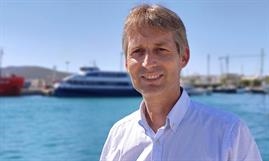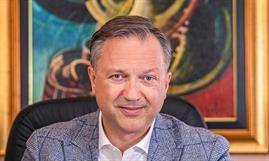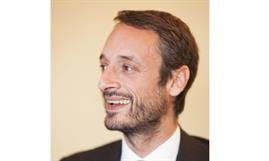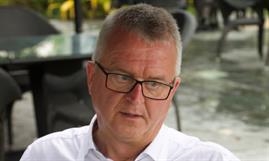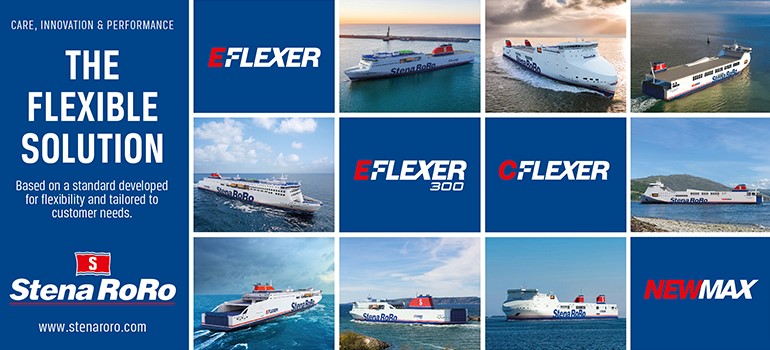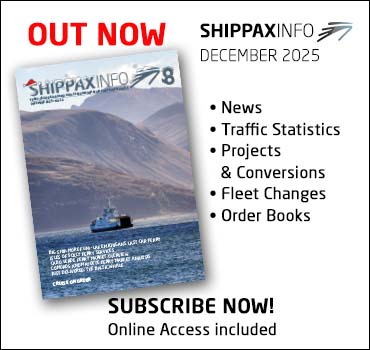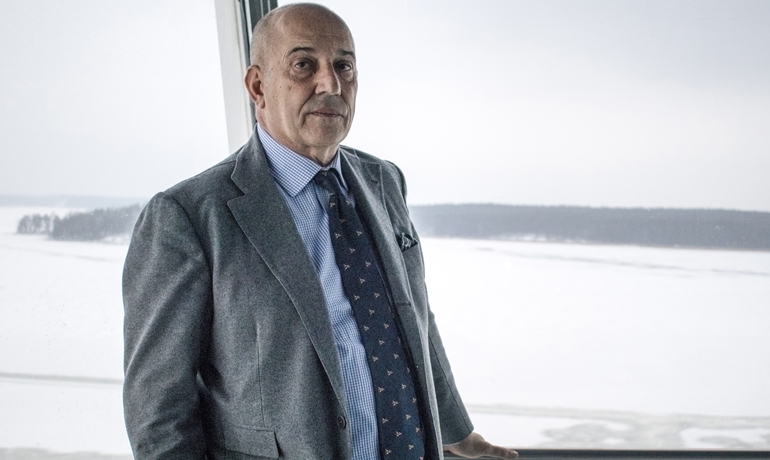
Emanuele Grimaldi © Grimaldi Group
STRATEGIC THINKING OF GRIMALDI GROUP
InterviewThe editor of Shippax recently visited the Naples headquarters of the Grimaldi Group to speak to its managing director Emanuele Grimaldi – who is primarily responsible for the group’s pan-European short-sea activities – about the company’s strategies and expansion plans. The Neapolitan shipowner has deep pockets. Besides the 12 next-generation GG5C Class short-sea ro-ros on order at Jinling Shipyard, it has six more GRANDE TORINO Class PCTCs under construction at Yangfan Shipbuilding. Grimaldi’s expansion appetite has not been fully whetted yet. Other new ro-pax tonnage is on the horizon. In addition to organic growth, Emanuele Grimaldi didn’t rule out further takeovers.
Emanuele Grimaldi has every reason to be proud of the group’s achievements. He and his elder brother Gianluca – who is in charge of deep-sea operations – are hand in glove and share the same seventh floor office in downtown Naples. Under their leadership, the group has grown dramatically. Besides Grimaldi Lines, the brand dedicated to the Mediterranean ro-ro and ro-pax activities as well as deep-sea activities with the so-called ‘yellow fleet’, the portfolio includes Finnlines, Minoan Lines, Malta Motorways of the Sea and Atlantic Container Line (ACL). But this list is not sufficiently exhaustive and Emanuele Grimaldi believes there is room for further consolidation in the ro-ro and ro-pax market, so watch this space!
In the company’s impressive boardroom on the first floor, he proudly showed me some pictures on his smartphone, which he had taken the before week when he and his son Guido were in Helsinki. “Look,” he said, with a little twinkle in his eye, “there were four Finnlines ships in port simultaneously – four ships!” Emanuele Grimaldi is a control freak type of person – in the positive sense – and he is very engaged in the day-to-day operations. He has all the details of his short-sea fleet in the back of his head, takes decisions fast, and is also heavily involved in the short-sea newbuilding projects, something he is particularly proud of, as he subsequently explained.
Shippax: How was the business in 2018? What are your expectations for this year and the next when the 0.5% sulphur cap becomes mandatory in non-SECAs?
Emanuele Grimaldi: In the Mediterranean it was to a certain extent a rather ‘complicated’ year.
The new sulphur emission regulations are coming soon and we had to do our homework. We had to start thinking and planning scrubber installations or other solutions. There have been a few consecutive years of fuel cost increases. At the same time, competition in the Med is really tough, especially in the Greek domestic market. This is equally the case in the Adriatic between Italy and Greece, and in the Italian mainland-Sicily trade competition is super strong. In these markets we have to learn how to survive with very low freight rates. So, rates are under severe pressure whilst at the same time (fuel) costs are rising. Despite all this, the result is all-in-all satisfactory. And when compared with those of our competitors, the results are actually good.
In the Baltic, Finnlines excelled; we made a record profit and EBITDA once again. We were also able to address some of the issues related to competition and operations that we inherited from the past and have reorganised some of the Finnlines trades in the best possible way. To further gain competitiveness we have lengthened six Breeze Class vessels. The extra cost in fuel consumption caused by the lengthening is negligible when considering the fact that the lengthening represented a total capacity increase of about 6,000 lanemetres.
We decided to long-term charter out the Kapellsakär-Långnäs-Naantali ro-pax FINNLCIPPER to Baleària and replace her by the FINNSWAN, the former NORDLINK, which was replaced by the sister vessel EUROPALINK on the Malmö-Travemünde route following her return from the Mediterranean. So, we gained another 1,000-lanemetre capacity, bringing the total for Finnlines to an impressive 7,000 lanemetres.
All our short-sea operations – both in the Med and in northern Europe – have suffered from the economic turmoil in Turkey, especially towards the end of last year. Needless to say that this has created a little bit of tension. It has also affected our PCTC deep-sea operations linking the Med with the US East Coast. We have increased volumes from Europe to the US and vice versa and, whilst exports from Turkey remain robust, the devaluation of the Turkish lira has dramatically reduced the import of rolling cargoes and cars, especially the more expensive cars.
In conclusion, I can say 2018 was another good year and we are now preparing ourselves for 2020 with a major scrubberisation programme for both our short-sea and deep-sea fleets. We prioritise the ships with the highest fuel consumption. Of course, all our newbuilds will have scrubbers installed.
Shippax: 2018 was also a pivotal year for ACL as rotations were reviewed, with the double call in Antwerp being axed and the direct Gothenburg call being replaced by a container feeder service and Grimaldi Lines’ existing ro-ro service from Wallhamn. Has this reviewed rotation been a success?
Emanuele Grimaldi: The G4s represented a totally new generation of con-ros ever built before; so teething problems were inevitable. This, together with the sheer size of the vessels and the problematic situation in Gothenburg with continuous labour disputes led to the decision to axe our direct call in Gothenburg, which had also represented a 3.5-day detour. To be honest, when we decided to stop calling directly at Gothenburg, we were initially worried that we would lose customers, but we didn’t. The feeder service for containers in combination with our ro-ro service from Wallhamn to Antwerp works extremely well. I can confirm that additional South Atlantic port calls to the south are no longer on the agenda. The management of ACL underestimated the size of these ships a bit, as we really need time to turn these ships round. Also, we feel that the weather conditions on the North Atlantic have deteriorated because of the climate change. There are more storms than before and it also affects the container shipping trade. The size of the ships in combination with unprecedented bad weather makes it very difficult to add port calls on the US side.
The North Atlantic trade is one of the most competitive market places for shipping, but our vessels don’t merely depend on containers. The container business will remain bad in the foreseeable future but, thanks to the ro-ro element of our business, we are in a rather unique position.
Shippax: Staying with ACL, I understand that there has been a major re-organisation on the land-side of its business. Could you elaborate on that?
Emanuele Grimaldi: Indeed, we didn’t only review the rotations. In Europe, ACL owned several agencies. This meant that the canvassing and the production of the cargo for ACL were handled by delocalised, standalone ACL offices. This was a cost-plus setup which was not the best solution as far as productivity was concerned. They had to sell just one service – North America. It was also not good for our image, as customers could get a visit by an ACL representative one day and then by a Grimaldi salesperson the next day. The German and Belgian offices of ACL have been merged with the existing Grimaldi offices. It was not aimed at making people redundant, as there were hardly any redundancies – it was rather synergy-driven. Under the wings of Grimaldi, it works much more efficiently now. Group-wide the local Grimaldi agencies operate as standalone third-party companies that survive on the commissions we pay them. This applies to our businesses in each and every country, even in Greece, where Minoan Lines is the agent of Grimaldi Lines. All our offices are treated like agents and therefore have to be more efficient and competitive than those working for their principals. But, obviously, their commitment and loyalty are higher because they are part of the same group.
Following the merger, ACL now pays a commission to the local Grimaldi agency. It is operating in a more cost-efficient way and can concentrate on the line rather than on its agency activities.
Shippax: To what extent will the Brexit affect ACL’s Liverpool office and the UK flag, which all five G4s are flying?
Emanuele Grimaldi: Things are a bit more complicated here. ACL is a Swedish company and there were plans to make it British, but we changed our mind due to the Brexit referendum result. All five G4 Class con-ros are registered in the UK, having Liverpool as their homeport. But we are strongly considering bringing ATLANTIC SAIL under the Italian flag, following an internal sale. Depending on the outcome of Brexit, we may be forced to change the flag on all five ships. As things are developing now, this might happen sooner rather than later since we risk an incompatibility between the flags, i.e. UK, and the country where ACL is registered, i.e. Sweden. It is a question of the law. In case of a hard Brexit, UK will no longer be part of the EU, so the UK flag might become incompatible. It is not easy to understand what Brexit means and what consequences it will have, but we have to avoid paying double taxes.
Shippax: Last year you ordered no fewer than twelve 7,800-lanemetre GG5G Class super freighters. Nine of them will be employed in the Med. They boast more than double the capacity of your ten Hyundai Mipo-built Eurocargo Class freighters. So almost overnight you will grow your capacity on certain routes by over 100%. How are you preparing this quantum leap and what about your ports? What routes will the new ships serve?
Emanuele Grimaldi: The market needs a surprise effect, but, as always, I have done my homework. I know exactly on what route each and every ship will serve and what ship they will replace. And for each ship that will be replaced, I know exactly where it will go, including the few ships that will be scrapped. There is a full scenario on paper and we have a detailed timeline for every single vessel. I drew it up myself with the assistance of our operational and commercial departments.
There is no doubt that these ships will be the best-in-class and will be an enormous success, as they will have the lowest fuel consumption of any short-sea ro-ro ship in the world and will have the lowest cost per transported unit. The ships will be able to call at our own terminals and we have started to enlarge those terminals that had insufficient marshalling space. In Spain, we already expended with Sagunto, 25km north of Valencia, and we are tripling the terminal capacity in Barcelona.
The ships will operate on a combination of international and domestic lines, but will primarily be engaged on the international lines.
Yes, our overall capacity will be increased significantly with the new ships and the fleet reshuffle this will bring about. As you know, Grimaldi Lines often operates certain lines from two ports to two ports. This means that the cargo is divided between several ports. The Genoa-Livorno-Catania-Malta route and the service linking northern Italy with both Barcelona and Valencia are good example of this. It is therefore doubtful that we will ever have to turnaround 15,600 lanemetres in a single port. This also means that we don’t need marshalling space for 5,000 or so trailers in our ports. The same applies for Finnlines, at least for the services that Finnlines’ three GG5Gs will operate. These ships will be tailor-made to the Finnlines requirements and those of the different commodities it carries, such as sto-ro cargo and cars.
Shippax: The GG5Gs will probably replace the Hyundai Mipo-built Eurocargo freighters, which, in their turn, will replace smaller and less efficient tonnage. Could you share some details of your plans?
Emanuele Grimaldi: As you know, nine ships will be operated under the Grimaldi Lines banner in the Med and three for Finnlines. The first four ships in the series are intended for the trade between the north of Italy and Spain. Two ships are earmarked for our north-south corridor from Genoa and Livorno to Catania and Malta. The three ships for Finnlines will replace Breeze Class vessels on the Biscay to the Baltic service. However, none of the Finnlines ships will be disposed of. Each of the replaced Breeze Class ships will move to the Baltic, as we will also increase our frequency and capacity there. We will increase the frequency on each of the Travemünde-Uusikaupunki-Turku, Rostock-Hanko and Gdynia-Hanko routes to six weekly sailings.
The last three vessels in the series will be introduced on a new service connecting Venice with Greece and Turkey. In the case of the latter, probably with a port in the Marmara region. This will be integrated into our existing Venice-Patras service. I’m not taking a big risk here, as half of the business is already in my pocket. I already have two 270-trailer ships in service between Venice and Patras and four PCTCs that connect the Adriatic with Turkey. These are primarily car carriers. Our GG5Gs will also carry cars. The Venice-Greece-Turkey service will be offered three times a week, supplementing our existing PCTC service.
I still have three to four years to prepare this new service, which will essentially be an extension of the Venice-Patras route. We are responsible operators and don’t want to destroy the business, but if the competition wants to keep us out, we are confident that we will succeed in finding a port willing to handle our ships since we have excellent connections in Turkey.
Shippax: You are reportedly to have offered a reward of USD 10,000 per day to Jinling Shipyard for each and every day they are able to deliver a GG5G ahead of schedule. Is this information correct?
Emanuele Grimaldi: It absolutely is as the vessels will generate more than USD 10,000 of profit per day once in service! I have offered them this money as it may help to avoid delays. But I’m afraid they can do very little about it. Delivering each ship one month early means good money for the yard, as it also means one year in total for twelve ships. So we are talking about USD 3.6 million, which is still peanuts considering the 12-ship contract is worth about USD 1 billion.
Shippax: You just explained that no single Finnlines ship will be disposed of following the introduction of the three GG5Gs. What about Grimaldi Lines? What ships will be sold for scrap?
Emanuele Grimaldi: I expect minimum three to four and maximum seven ships to leave the Grimaldi Lines fleet. The likely candidates to go out are EUROCARGO SALERNO, VALENCIA, and ISTANBUL, which are three sister ships, EUROCARGO NAPOLI and the sister EUROFERRY MALTA, EUROCARGO TRIESTE, and PATRASSO. If I get a good price, they will not be sold for scrap. Today there are people who are interested in paying EUR 15 million per vessel, which is much more than the scrap value.
Shippax: Don’t we risk falling second-hand prices as you are not the only one who’s introducing new and larger tonnage?
Emanuele Grimaldi: Yes, this is what we expect. The situation might be somewhat similar to that of when our Hyundai Mipo ships and the eight ro-ros built by the Odense shipyard arrived on the market. The market depressed, but this was also related to the financial crisis. Perhaps it’s time to scrap very old vessels from the seventies and early eighties – those that still have lifts. Our ships – even those that will be disposed of – are superior to many ro-ros that are still around. I call for scrapping of the really old ro-ro freighters and when I don’t find a good buyer for my redundant ro-ro tonnage, I will just scrap them.
Shippax: We have seen a consolidation wave in recent years. The take-over of Trasmediterránea by Armas and U.N. Ro-Ro by DFDS are cases in point. Industry observers believe that there is still room for consolidation. Are you at the consolidation table?
Emanuele Grimaldi: There is much more room for consolidation and our group will be part of it. It is reasonable to assume that this will happen. We are ready to listen and to invest, but, unfortunately, short-sea shipping is very political and has a lot of history. It is difficult to do things without the willingness of the other party. If we don’t get any opportunity to further expand through takeovers, then we can still opt for organic growth. As a matter of fact, the 12 GG5Gs in combination with new ro-paxes we expect to order soon will help us to pursue organic growth. But should opportunities arise and the other party is prepared to sell, we are ready.
Shippax: The bottom line is that the market will become less fragmented, right?
Emanuele Grimaldi: Theoretically I think there are only five European operators that are in a position to buy and there are 40 or so who might have to sell. This is the scenario for the Baltic, North Sea and the Mediterranean. I just wonder how, for example, two Polish ferry operators can still exist on their own. And there are many other examples.
Shippax: What about a company like Viking Line? On social media I saw that you, your son Guido, and Luca Marciani, one of your PAs, travelled on VIKING GRACE last summer…
Emanuele Grimaldi: Who posted this on social media? Well, yes Mr Jan Hanses travelled with us and they treated us very well. I prefer not to comment and all I can say is that it’s a Finnish quality operator that would nicely complement our business in the Baltic as their model is passenger-oriented whilst ours is freight-oriented. These are two totally different products where the one can learn from the other. I guess competition authorities wouldn’t have any objections and a company like Viking Line would be better off when in the hands of a major group.
Shippax: During last year’s Euro-Med convention in Lagonissi, you said that the new Superstar Class ro-paxes would have a higher passenger capacity than the Star Class ships, one of which served the Kapellskär-Långnäs-Naantali route.
Emanuele Grimaldi: On the Superstar Class, freight drivers will be king and we will create more room and more cabins for them. There will be about 350 cabins in total, 200 of which will be dedicated to freight drivers. The majority of these cabins will be single berth, with only a small proportion of double berth driver cabins which will typically be used by drivers who are travelling in one cab.
Shippax: How is the Superstar Class project progressing? When do you expect to order and how many ships will you eventually order?
Emanuele Grimaldi: The order will be placed within one year. We have made a lot of progress on the project. It’s an in-house Grimaldi-Finnlines project, developed together with Knud E. Hansen. I take a very active role and we are still constantly changing the concept. Ultimately, the final design will come from the yard that will build the ships.
We will go to all the major yards – including European yards – and I expect that about ten top yards will be put one against another. Ultimately, the price, quality, and delivery time will determine which yard we will choose.
We will order two ships only since technology – especially battery technology – is developing fast. The new ships will serve a line or lines where we don’t require a high service speed, but rather a 17-knot speed. Since speed is not a prerequisite, we will probably opt for a hybrid solution. We are following the development of battery technologies with great interest and therefore we take a careful approach when it comes to the number of ships we will order – it won’t be four ships. The battery of the future will be a solid battery which is less dangerous than the liquid ones. All-solid batteries will be much cheaper than today’s batteries. But it’s not only batteries, we also follow all other technological developments.
For cost and environmental reasons, fuel efficiency is at heart of the concept. Suffice to say that the Superstar Class will have a higher intake than the Star Class, but perhaps half the power. The ships will have scrubbers and will operate with zero emissions at berth either by applying cold ironing or using their own batteries. We will only opt for cold ironing if we get cheap electricity, otherwise we will produce our own electricity on board to charge batteries that will supply the hotel load in port. The ships will be state-of-the-art and we are even studying automated docking.
Shippax: How about new ro-pax tonnage for the Mediterranean?
Emanuele Grimaldi: I can give you a scoop here: we are developing a totally new ro-pax class that is a further evolution of our successful Cruise Class ships. They will actually bear some similarities with the Cruise Class. We are already in advanced discussions with yards for two, plus one, plus one, plus one and we expect these ships to be ordered even before we order the Superstar Class. I can tell you that we were recently sitting in this room with Chinese engineers.
Shippax: Do you expect the new Cruise Class ships to be built in China?
Emanuele Grimaldi: We haven’t made any decision yet and could potentially go to a European yard. As far as ro-pax and cruise ships are concerned, I believe that some European yards remain competitive against Chinese yards. In Europe you can build a ship in two years’ time, whereas this takes three years in China. Don’t forget that this one-year difference represents a lot of money.
I am confident that the process of robotisation, dronisation and Artificial Intelligence, etc., will improve the competitiveness of the European yards and Europe as a whole. The delocalisation will lose the strength it used to have. China will primarily build for Asian interests in the future. It is also very likely that building in China will become more expensive as wages increase.
Welding in Europe used to be a very expensive activity. It was a dirty job and a welder was therefore well paid. But machines are taking over and a lot of jobs are automated, reducing the building cost. Look at what Mercedes-Benz is doing in Uusikaupunki, Finland; it is quite the opposite of the cheap delocalisation. They build electric cars there, so do you really need to go to China to build an electric car in the future? In today’s world, the people behind the construction are white collars – specialised engineers – and no longer blue collars.
Having said this, I admit that the Chinese yards are still the most competitive shipbuilders. Our group has built many ships there and will also do so in the future. But when it comes to ro-pax ships, Europe can bounce back and as Europeans it’s our duty to try that. Look at what Fincantieri is doing with our Cruise Class ships (he then showed the latest pictures of the lengthening of CRUISE ROMA at the Fincantieri’s Palermo yard on his cell phone); it’s an investment of EUR 100 million for two ships. They will be lengthened, refurbished, and have batteries and scrubbers installed.
Shippax: Could you give some details on this new ro-pax generation for the Med and the routes the ships will serve?
Emanuele Grimaldi: This will be the best-in-class ships once again in terms of technology, quality and price. They will have a capacity of about 2,500 passengers, will boast about 400 cabins, 3,000 freight lanemetres and 1,000 car lanemetres. The ships will have a 24-knot maximum speed and will be equipped with scrubbers. We are also looking at LNG propulsion but supply and price in the Med are still a problem, not to mention that it’s an intermediate solution.
The newbuilds could serve many of our routes, for instance to Crete, Livorno-Palermo, Brindisi-Igoumenitsa, Savona-Tangier or Tunisia. They will either replace or supplement existing tonnage to improve the service.
Shippax: Would you consider developing a ro-pax that fits both Grimaldi Lines’ and Finnlines’ requirements just like Stena is doing with its E-Flexer?
Emanuele Grimaldi: No, since the requirements for Finnlines and Grimaldi are different. Just to give an example: for Finnlines we need 1A ice class and powerful heating, whereas in the Med we need more air conditioning capacity.
Shippax: What is on your Greek agenda?
Emanuele Grimaldi: We really don’t know what Attica and Anek Lines are up to. We need a better understanding and want to wait and see what will happen before taking any initiative. There are currently too many question marks and uncertainties in the Greek market. I have a lot of ideas for Greece, but they need to be commonly shared. I’m not talking about an idea which is only good for me, but would be good for everybody. But today’s picture is really blurry – it’s even not clear who is who and who is doing what. We are in a position that we control a company – Minoan Lines – with zero debt. We have financial resources and are looking at what can be done to further grow the business. We are investing in scrubbers on all three conventional Minoan Lines ferries – including the MYKONOS PALACE, which we added last year.
Shippax: In autumn 2018 you further expanded your network to Sardinia with a three times weekly Genoa-Porto Torres route and a triangular Civitavecchia-Olbia-Cagliari route. These are freight-only services. How are they performing?
Emanuele Grimaldi: We are happy with the filling rates, considering it’s a new service. Today we control 60% of the Sardinian freight market. So we are the number one freight carrier by far. The remaining operators have a more modest 40%.
Shippax: Let’s wrap up with a few more questions about your deep-sea activities. You have six more PCTCs under construction at Yangfan Shipbuilding. Will they replace the chartered tonnage?
Emanuele Grimaldi: These ships are heavily delayed and many shipyards in China are struggling to deliver on time. Yes, the ships will replace the chartered tonnage.
Shippax: Would you consider a service to East Africa and/or extend your West Africa (WAF) service to South Africa? On the subject of the WAF service, are you feeling the competition from MSC, which is now operating two large, former Linea Messina con-ros on this market?
Emanuele Grimaldi: There have been talks of extending the WAF service to South Africa, but I understand the range is to Angola. However, should a car manufacturer offer us a shipment of 100,000 cars per year from South Africa to Europe, then we would obviously extend the line to South Africa.
MSC competes with just two ships and possibly competes with its own container service. But, generally, I would say that competition is good for the market and keeps us focused.
Shippax: You earlier announced the intention to order the next-generation Grande Class con-ros for your services to West Africa and South America. Can we expect an order soon?
Emanuele Grimaldi: The development of this new class will take another few years, I believe, as we will take our time and are not in a hurry. This will be an order of five ships minimum since this is the number required to cover a string. You don’t want to build the same ship you have done before. We will focus on fuel efficiency, reducing carbon footprints, and minimise emissions in port, etc. In today’s world, you need to do a lot of homework. And this is exactly what we are doing.
We use the time to implement the latest technology. This is also what we did when we ordered our Cruise Class ships 14 years ago. More than ten years after their introduction these are still the best-performing ro-paxes in the Mediterranean, achieving financial results that are second to none. These ro-paxes are better than any other ship in our Mediterranean fleet, let alone those in the fleet of the competitors. Actually, the same goes for Finnlines’ Star Class. The Cruise and Star Class ships have the best results in the group, simply because there is a lot of thinking and technology behind them. Their fuel consumption is on par with the way-smaller-capacity Superfast ships which we equally operate. Whilst expenses are the same, revenues are double.
Shippax: That’s what I would call ending on a positive note!
© Shippax / Philippe Holthof
apr 01 2019
Most read
Scottish government to nationalise Ardrossan Harbour and carry out major upgrading programme to be able to dock new CalMac ferries
jan 09 2026


